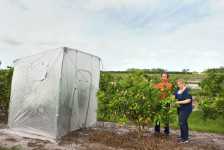Scientists Turn Up The Heat On HLB

Recently, USDA’s Agricultural Research Magazine published a story on research from Dr. Youngping Duan in Ft. Pierce, FL. Duan is based at USDA’s Horticultural Research Lab there.
Working with the Florida Department of Agriculture and Consumer Services (FDACS), Duan and his Agricultural Research Service colleagues have found a formula for curbing HLB, offering the industry a glimmer of hope.
Duan has published details of work showing that heating potted citrus seedlings in greenhouses kills off the HLB bacterium and can rid the seedlings of HLB symptoms. Monitoring efforts show that the benefit can last for at least two years.
In a separate field trial, Duan also found that heating HLB-infected trees in the sun by encasing them in plastic “tents” can prolong their productivity. Results of the field trials have yet to be published, but Duan says heating trees in solar tents may offer relief to growers whose citrus groves are being devastated. “We can’t guarantee 100% elimination, but it can keep production up for longer periods,” Duan says.
Greenhouse Results
In the greenhouse experiments, Duan and his ARS colleagues Michele Hoffman, Melissa Doud, David Hall, and Ed Stover, along with FDACS scientists, exposed 30 HLB-infected citrus seedlings to different levels of heat in growth chambers for periods ranging from two days to 10 days. The seedlings were about 2.5 years old, about 2 feet in height, and were growing in 1-gallon containers. They were divided into three groups and heated to 104°F, 107°F, or 113°F. Fluorescent lamps provided light for 12-hour “days” and were turned off for 12-hour “nights.”
For comparison, the researchers also applied the heat treatments to citrus budwood and periwinkle, which is also susceptible to HLB. They used PCR technology, which amplified the pathogen’s DNA, to measure the HLB pathogen levels in the trees, budwood, and periwinkle. Infection levels were measured a week before heat treatments began and again 30, 60, and 270 days after they ended.
The researchers quickly learned that constant exposure to temperatures of 113°F or higher would defoliate citrus seedlings. But if they interrupted the steady onslaught of intense heat by dropping temperatures down to about 80°F for at least five hours each day, the leaves stayed alive.
Results from the greenhouse tests, published in the journal Phytopathology, also showed that exposing citrus seedlings to a minimum of 48 hours of temperatures of 104°F to 107°F significantly reduced, and often eliminated, HLB infection. All of the heat treatments were equally effective, regardless of temperatures and exposure times. The researchers continued to test the seedlings, and after two years of heat treatments, they have remained free of HLB. “This application would be useful for nurseries and greenhouses and rescue of germplasm that’s been infected,” Duan says.
By contrast, exposing newly grafted budwood to alternating temperatures of 102°F and 86°F for up to four months did not reliably cure it. The heat controlled the HLB in periwinkle, but the periwinkle plants were more heat tolerant than the citrus trees and required more prolonged heat for infection levels to be reduced.
Tents In The Grove
Another approach to controlling HLB damage may have wider implications by prolonging the productivity of citrus-producing trees. Florida citrus grower David McKenzie, working with Duan, has been encasing citrus trees in opaque, plastic PVC “tents” to heat them up for about a week, then removing the tents and trimming off the top 10 or 12 inches of the trees that have been “browned up” by the solar heat.
The results have been striking. Within short periods of time, leaves stunted by HLB begin to flourish, and by the time the fruit is ready for harvest, its quality is noticeably improved.
“The flush after the tents are removed is phenomenal. The leaves start to flush about two to four weeks after the tent is removed, and that flush will peak after about six weeks,” McKenzie says.
McKenzie has been using the tents for about a year and a half, applying them from April to September. He has covered about 1,000 of his 130,000 trees, working in alternating 20-acre blocks and tenting about 5 trees at a time in each block. He selects trees with moderate HLB symptoms (smaller, shriveled fruit and stunted leaves) that are about three to six years old and 6 feet high. He uses cinder blocks to hold the tents in place and positions the tents so their tops are near the tops of the trees and they drape closely around the tree circumference. That way, by mid afternoon the heat in the tents reaches about 125°F near the treetops and about 110°F near the base.
“Once trees reach a certain size, maybe to where they have a 25-foot circumference, that’s about the maximum size for using the tent. What is important is for the top of the tent to be close to the top of the tree, so you have heat at the top,” McKenzie says.
Tents can be reused, and McKenzie estimates that with labor, the system costs about $45 per tent. He says the results are worth the effort.
“We’re finding that the trees we tented last year don’t need to be tented this year. Trees with major symptoms before the treatment have minor symptoms after treatment, and the trees are producing normal fruit where they were producing small fruit before,” McKenzie says.
As with the potted citrus, Duan is unsure about the specific biological causes underlying the results. HLB is a systemic disease, and eliminating it from a tree generally requires eliminating it from the roots. The heat doesn’t entirely kill off the HLB in the tree, but it seems to weaken the infection process and prolong the tree’s productive life. “It works better if the infection is in its early stages and the bacteria have not yet reached the plant root,” Duan says.









